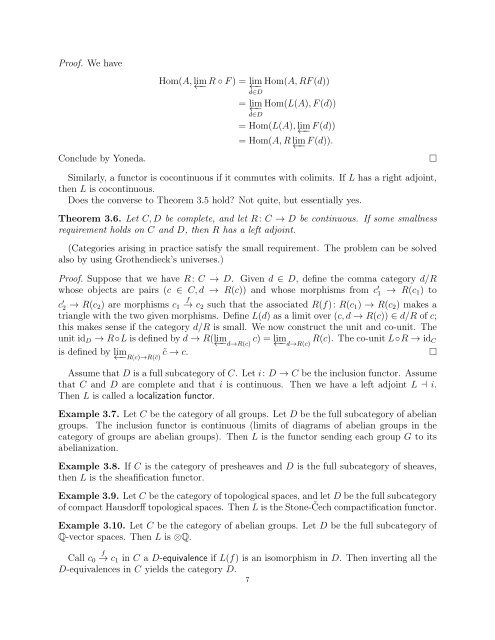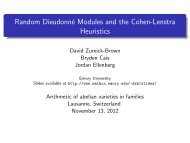alternative lecture notes - Rational points and algebraic cycles
alternative lecture notes - Rational points and algebraic cycles
alternative lecture notes - Rational points and algebraic cycles
You also want an ePaper? Increase the reach of your titles
YUMPU automatically turns print PDFs into web optimized ePapers that Google loves.
Proof. We have<br />
Conclude by Yoneda.<br />
Hom(A, lim R ◦ F ) = lim Hom(A, RF (d))<br />
←− ←−<br />
d∈D<br />
= lim Hom(L(A), F (d))<br />
←−<br />
d∈D<br />
= Hom(L(A), lim ←−<br />
F (d))<br />
= Hom(A, R lim ←−<br />
F (d)).<br />
□<br />
Similarly, a functor is cocontinuous if it commutes with colimits. If L has a right adjoint,<br />
then L is cocontinuous.<br />
Does the converse to Theorem 3.5 hold? Not quite, but essentially yes.<br />
Theorem 3.6. Let C, D be complete, <strong>and</strong> let R: C → D be continuous. If some smallness<br />
requirement holds on C <strong>and</strong> D, then R has a left adjoint.<br />
(Categories arising in practice satisfy the small requirement. The problem can be solved<br />
also by using Grothendieck’s universes.)<br />
Proof. Suppose that we have R: C → D. Given d ∈ D, define the comma category d/R<br />
whose objects are pairs (c ∈ C, d → R(c)) <strong>and</strong> whose morphisms from c ′ 1 → R(c 1 ) to<br />
c ′ f<br />
2 → R(c 2 ) are morphisms c 1 → c2 such that the associated R(f): R(c 1 ) → R(c 2 ) makes a<br />
triangle with the two given morphisms. Define L(d) as a limit over (c, d → R(c)) ∈ d/R of c;<br />
this makes sense if the category d/R is small. We now construct the unit <strong>and</strong> co-unit. The<br />
unit id D → R◦L is defined by d → R(lim c) = lim R(c). The co-unit L◦R → id C<br />
←−d→R(c) ←−d→R(c)<br />
is defined by lim ˜c → c.<br />
□<br />
←−R(c)→R(˜c)<br />
Assume that D is a full subcategory of C. Let i: D → C be the inclusion functor. Assume<br />
that C <strong>and</strong> D are complete <strong>and</strong> that i is continuous. Then we have a left adjoint L ⊣ i.<br />
Then L is called a localization functor.<br />
Example 3.7. Let C be the category of all groups. Let D be the full subcategory of abelian<br />
groups. The inclusion functor is continuous (limits of diagrams of abelian groups in the<br />
category of groups are abelian groups). Then L is the functor sending each group G to its<br />
abelianization.<br />
Example 3.8. If C is the category of presheaves <strong>and</strong> D is the full subcategory of sheaves,<br />
then L is the sheafification functor.<br />
Example 3.9. Let C be the category of topological spaces, <strong>and</strong> let D be the full subcategory<br />
of compact Hausdorff topological spaces. Then L is the Stone-Čech compactification functor.<br />
Example 3.10. Let C be the category of abelian groups. Let D be the full subcategory of<br />
Q-vector spaces. Then L is ⊗Q.<br />
f<br />
Call c 0 → c1 in C a D-equivalence if L(f) is an isomorphism in D. Then inverting all the<br />
D-equivalences in C yields the category D.<br />
7



